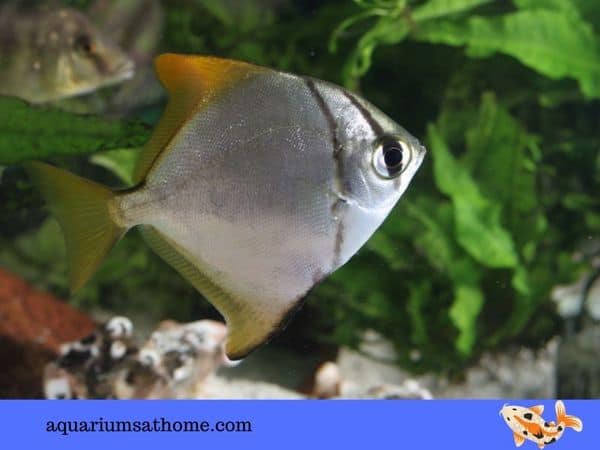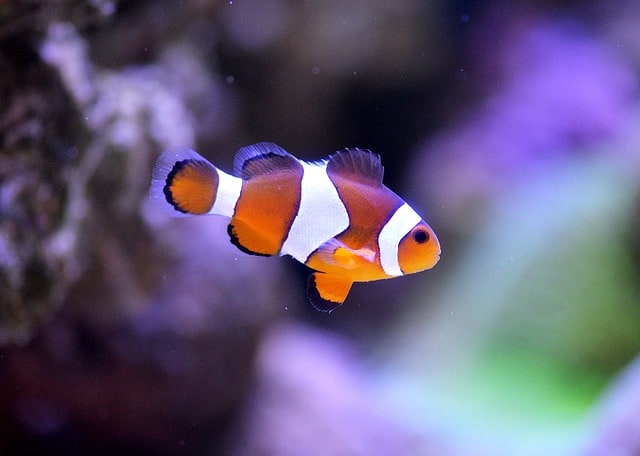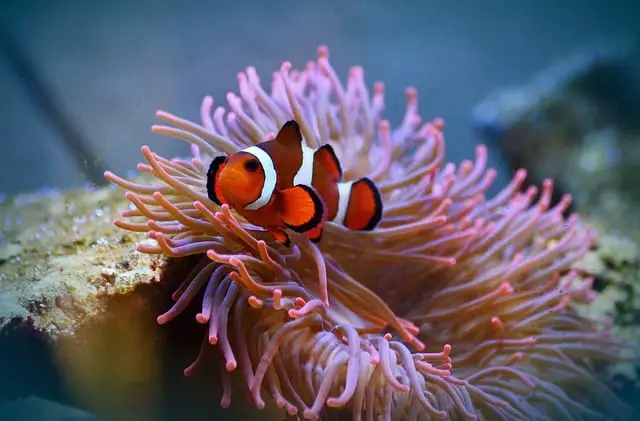Brackish water tanks are gaining popularity with aquarium hobbyists worldwide. They’re unique and make for great conservation while viewing with others. If you’re considering setting up a brackish tank, you may be wondering just what you need to get started. Well, I have the answer for you below…
To start a brackish tank, you need the following equipment: fish tank, aquarium, filter, heater, light source, thermometer, hydrometer, substrate, marine salt mix, and water conditioner. It takes about 2 to 4 weeks for the water to go through the nitrogen cycle, after that, you can add brackish fish.
Now that you know the necessary equipment required for setting up a brackish water aquarium, let’s take a closer look at this topic. I’ll explain in more detail what brackish water is, which plants and fish can survive in it, and how to aquascape your brackish tank.
So, if you’re ready to learn more about brackish tanks and how to set-up as well as maintain them, then let’s get to it…
What is a Brackish Tank?
A brackish water aquarium is one whereby the water in the tank is ‘semi-salty’ – in between freshwater and saltwater. How much salt you need for a brackish tank is determined by the species of fish you want to keep and the type of aquatic environment they originated from.
Naturally occurring brackish water is found in estuaries – costal bodies of water where rivers meet the ocean. The salinity level ranges from 0.5 to 35 ppt and is dependent on the region. It’s not the amount of salt but rather the minerals, sediment and algae in the water that make it appear brownish in color.
To maintain salinity in your brackish tank, you’ll need a hydrometer like these ones on Amazon.
Unlike in the wild where brackish water looks ‘dirty’, it’s clear in a confined environment such as an aquarium. Should the water in your brackish tank take on a cloudy appearance, then it’s likely the result of a bacterial bloom caused by overpopulation (fish poop) or overfeeding.
If you have live plants, the cloudy water could also be caused by decaying plant leaves. Therefore, it’s imperative to remove dead plants from the tank as soon as possible.
How Long Does It Take to Set-up a Brackish Tank?
In general, it can take as long as 2 weeks to set-up a brackish tank, unless you’re not fussy in which case, setup itself can a little as a day! Aquarium salt is added gradually and tested continuously to ensure the proper parameters (pH, salinity, ammonia, and nitrite levels as well as temperature range) are met.
Knowing what brackish fish you want to keep will help you choose which rocks or other structures you should place in the tank. You need to give your fish ample space to swim freely and as well as provide hiding places for cover.
It can take up to 8 weeks for your brackish tank to cycle (Nitrogen cycle) completely – whereby the ammonia and nitrite levels test at 0 or low (1 to 2) – before it’s safe for adding fish. To speed-up the process, you can add a biological enhancer to the water so fish can be added sooner (around week 4).
You should keep adding the biological enhancer after adding fish. These products work very well but need to keep being added as they are only a temporary fix. Once you stop using them, the water parameters will go back to whatever they truly are not what the product masks them to be.
Pro tip: Don’t use charcoal in your filter when using a biological enhancer as the charcoal will absorb the product rendering it virtually useless and a waste of your time and money. It would also be dangerous to your fish.
Check out the following well-rated biological enhancers available online through Amazon.
How Much Salt Do You Need in a Brackish Water Aquarium?
The amount of salt required for a brackish water aquarium depends on the size of the tank and the types of fish you have. In general, you need approximately 2 tablespoons of salt for every gallon of water. The pH level should be between 7.8 and 8.4 with an alkalinity of 180 to 360 ppm.
A marine salt mix is the easiest and safest way to mimic the biological parameters of brackish water in the wild. Avoid using table salt, however, as the excess silicates and iodine can be dangerous for fish. And, never add undiluted salt directly to the aquarium.
Check out the following high-quality marine salt mixes available online through Amazon.
Can I Use Aquarium Salt to Make Brackish Water?
Basic aquarium salt can be used to make brackish water, although I’d recommend a marine salt mix instead. The difference is that aquarium salt is simply sodium chloride whereas marine salt mix contains minerals such as calcium and trace elements like iodine that are also found in sea water.
The correct way to use and add salt for brackish water changes includes the following:
- begin by adding RO water or treated tap water to a bucket
- heat the bucket water to the same temperature as the tank
- slowly add the correct amount of marine salt to the bucket water and stir well
- let the bucket water mixture sit for 20 minutes or until all the salt is dissolved
- stir the bucket water again before adding it to the tank
- measure the specific gravity of the water with your hydrometer to ensure the correct levels
What Water Conditions are Required for a Brackish Tank?
When setting up a brackish tank, you need a heater to maintain the temperature between 75 degrees Fahrenheit and 83 degrees Fahrenheit. In Celsius the temperature range is 23.8 to 28.3.
A pH between 7.2 and 8.5 is also recommended.
Use your hydrometer to test the salinity levels regularly as some brackish fish require a slight increase in their salinity every 6 months.
Pro tip: When the tanks water level lowers because of evaporation, you don’t have to add more salt to the water used to top up the tank. This is because water evaporates but salt doesn’t. When your tank’s water level is lower than usual, this also means the salinity of the tank will be higher.
The only time you’ll add more marine salt to the new water is when you’re performing a water change and vacuuming the substrate. When you take out saltwater, you must replace it with saltwater.
What Plants Grow in Brackish Water?
Growing live plants in brackish water can be tricky, as most aquatic greenery can’t sustain a saltwater environment. I’d recommend artificial plants instead but if real plants are the way you want to go, then you’ll likely have the most luck with the following:
Anubias Plant
This aquatic plant is often found in the swampy jungles of western Africa. It’s tough, slow-growing and likes to attach itself to hard surfaces such as rocks and driftwood. It can even adapt to diverse lighting conditions and abrupt changes in temperature.
Anubias plants are readily available at most local fish stores or online.
Java Fern
This species of plant is extremely resilient and can survive in the harshest of aquatic environments. It originated in the jungles of South East Asia and can even thrive in a brackish tank if properly maintained. It will grow near a hard surface such as rocks or wood in a tank rather than on a sand or gravel bed.
Sago Pondweed
This plant species is found worldwide but is native to North America. It’s very hardy and can thrive in both acidic and alkaline aquatic environments. It’s even safe for herbivore fish to nibble on. This ‘tough-as-nails’ plant can sustain varying temperatures as well as fluctuating pH levels.
Wendt’s Cryptocoryne
Much like the anubias plant, cryptocoryne is native to Sri Lanka found naturally in the swampy jungle streams of southern Asia. An easy-to-care-for plant, this species prefers fertile, gravel substrate and can tolerate a wide range of lighting conditions and temperature fluctuations.
How to Aquascape a Brackish Tank?
To aquascape a brackish tank, it’s recommended you use artificial plants in a variety of shapes and colors. Most live aquatic plants can’t survive in salty water and the ones that can, generally look the same – green, weedy, or shrubby in appearance.
Begin by placing larger, leafy plants near the back of the tank with smaller, more colorful ones up front. Don’t overload the tank – there should still be plenty of space for fish to swim about freely. Add rocks, driftwood, etc. and place them on varying levels of substrate. Be creative and unique in your approach.
As with all fish tanks, make sure the fish will have spots to hide. You’ll want to consider how you might place power heads in the tank when setting up the plants and rocks to maximize the flow of the water. This benefits the filtration of the tank and the fish will likely enjoy having a current to swim in.

What Fish Live in Brackish Water?
There are many species of fish that can thrive in a well-maintained brackish aquarium. These include archerfish, catfish, cichlids, danios, gobies, pufferfish, scats, filefish and targetfish. Other aquatic creatures such as crab-eating frogs, and mudskippers can also survive in a brackish tank.
There are also some freshwater fish like guppies and mollies that can adapt to a brackish environment. Upon purchase, be sure to inquire which type of tank they’ve been kept in. If kept in freshwater, then you must acclimate them in a bucket for several hours before introducing them to your brackish tank.
If you plan on keeping any true brackish fish, I’d reconsider adding guppies or mollies, especially if they’re quite small. The much larger brackish fish could attack and kill the smaller fish.
While some saltwater aquarium fish may be able to live in a brackish tank, I’d caution you against it. Many marine fish are ‘finicky’ and require very specific water, lighting, and temperature conditions. Therefore, their chances of survival in a fluctuating, brackish aquatic environment would be slim.
Is Brackish Water Hard to Maintain?
Contrary to popular belief, a brackish aquarium isn’t that difficult to maintain, provided you have the right equipment. Like freshwater and saltwater aquariums, brackish tanks also require regular water changes as well as routine water testing to ensure the safety and health of its inhabitants.
Since the fish that are usually kept in brackish tanks tend to be hardy and highly adaptable, it’s easy to both feed and care for them. Vacuuming the substrate occasionally along with cleaning the inside of the aquarium glass with an algae skimmer will also help maintain your tank.
Once your tank is established, cleaning the filter once every 4 weeks is sufficient.
When the tank is new and still getting established, you’ll want to give beneficial bacteria the most opportunities possible to grow. Water changes will be more important at this stage than cleaning substrate and filters. It doesn’t mean don’t do it, however!
It’s a fine balancing act and the longer you have the tank up and running, the better you’ll get at determining which tasks should be performed.
Conclusion
To conclude, you need specific equipment to set-up a brackish water aquarium. A tank, filter, heater, light, thermometer, hydrometer, substrate, marine salt mix, and water conditioner are required. Live or artificial plants can also be added if an aquascape environment is what you’re after.
A powerhead can be added for stronger currents, but it’s not necessary for a successful tank.
I hope this article has answered your questions regarding how to start and maintain a brackish water aquarium. Thanks for reading and good luck with your aquarium hobby.
Related Posts
Popular Types of Brackish Water Fish For a Home Aquarium
Are Columbian Sharks Aggressive?




